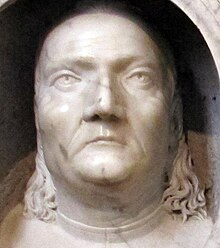
Back انتونیو دل پولایولو ARZ Antonio Pollaiuolo Catalan Antonio del Pollaiolo Czech Antonio del Pollaiuolo German Antonio Pollaiuolo Esperanto Antonio Pollaiuolo Spanish Antonio del Pollaiolo Estonian Antonio del Pollaiolo Basque آنتونیو دل پولایولو Persian Antonio del Pollaiolo Finnish
Antonio del Pollaiuolo | |
|---|---|
 Antonio del Pollaiuolo, detail of his tomb | |
| Born | c. 17 January 1429 or 1433 |
| Died | 4 February 1498 (aged 69) |
| Known for | Italian Renaissance painting, sculpture, engraving, goldsmithing |
| Notable work | Battle of the Nudes, 2 papal tombs |
Antonio del Pollaiuolo (UK: /ˌpɒlaɪˈwoʊloʊ/ POL-eye-WOH-loh,[1] US: /ˌpoʊl-/ POHL-,[2] Italian: [anˈtɔːnjo del pollaˈjwɔːlo]; 17 January 1429/1433 – 4 February 1498), also known as Antonio di Jacopo Pollaiuolo or Antonio Pollaiuolo (also spelled Pollaiolo), was an Italian Renaissance painter, sculptor, engraver, and goldsmith, who made important works in all these media, as well as designing works in others, for example vestments, metal embroidery being a medium he worked in at the start of his career.
His most characteristic works in his main media show largely naked male figures in complicated poses of violent action, drawing from classical examples and often centred on a heroic Hercules. He, or possibly his brother, was also a innovative painter of wide landscape backgrounds, perhaps having learnt from Early Netherlandish painting.[3] His two papal tombs were the only monuments to survive the demolition of Old St Peter's in the next century and be reconstructed in the present St Peter's Basilica.[4]
He very often worked in collaboration with his younger brother Piero del Pollaiuolo (c. 1443–1496), and distinguishing their contributions to satisfy modern ideas of authorship has proved exceptionally difficult, so that many paintings are just described as by the Pollaiuolo brothers.[5] Contemporaries, and Giorgio Vasari, saw Antonio as by far the more talented, and responsible for the design and main painting of most works,[6] but in recent decades the reputation of Piero has strengthened somewhat, and he is now given sole authorship of, for example, the small Apollo and Daphne (1470–1480) by its owner, the National Gallery.[7] At the same time, contemporary references in lists of leading artists, of which there are a number, mostly mention the brothers together,[8] and Vasari's Lives of the Artists treats them in a single life.
According to Kenneth Clark, two factors have reduced his prominence in the modern view of Quattrocento art: the loss of his very large paintings of some of the Labours of Hercules, and "a name which looks difficult to pronounce". In his own day, and for several decades later, his "true position" as "one of the originating forces in the history of European art" was recognised.[9]
- ^ "Pollaiuolo". Lexico UK English Dictionary. Oxford University Press. Archived from the original on 22 March 2020.
- ^ "Pollaiuolo". Collins English Dictionary. HarperCollins. Archived from the original on 29 July 2019. Retrieved 29 July 2019.
- ^ Hartt, 316–317; Seymour, 179
- ^ Ettlinger, 239
- ^ Wright, 1–2; Seymour, 179
- ^ Vasari
- ^ Tempera on wood, 30 × 20 cm
- ^ Wright, 7–9
- ^ Clark, 181